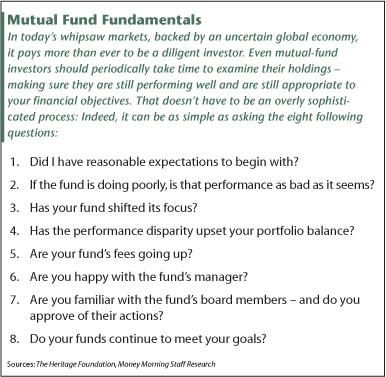Some Good Reasons to Dump Your Mutual Funds
Post on: 4 Апрель, 2015 No Comment

Exclusive FREE Report: Jim Cramer’s Best Stocks for 2015.
A couple of years ago I predicted the demise of mutual funds. I thought savvy investors would recognize the pitfalls in traditional funds and move to individual stocks and hybrid funds.
Then the market plummeted. Individual stocks became treacherous, and many experts argued that mutual funds proved their mettle during the market doldrums.
Fine. But financial planners think differently. They are moving rapidly away from mutual funds and into the exchange-traded funds on the Amex. where there are now close to 100 choices, ranging from broad market indices to an index of Real Estate Investment Trusts (REITs) to a Goldman Sachs natural resources index. There are a half-dozen different value and growth indexes, and the only health-care index fund available anywhere, so far as I know.
The exchange-traded funds are all index funds. Each one follows an index such as the Standard & Poor’s 500 SPDR Trust (SPY ) or the Dow Jones 30 Industrials Diamonds Trust (DIA ) or the total stock market as measured by the Wilshire 5000 Vanguard Vipers (VTI ). None of the funds is actively managed, although experts say active funds will be available as exchange-traded funds, perhaps next year or the year after.
Cheap, Pure and Efficient
So what’s the appeal? Three things: Low expenses, tax efficiency and purity of asset class, an important characteristic for a financial planner who is trying to set up an asset allocation strategy for clients.
The difference between investors who prefer active management and those like Harold Evensky who move clients’ assets to exchange-traded funds is that the active group still has faith that at least some managers can beat the market.
Where you come down on the active vs. passive argument will determine whether you like exchange-traded funds. If you like passive management, you have a choice between the low-cost Vanguard or TIAA-CREF mutual funds and the exchange-traded funds.
So let me give you a quick background on ETFs, which are hybrids: a cross between the open-end mutual funds and the closed-end funds that have traded on exchanges for decades.
Four Strikes Against Old Funds
The big disadvantages to traditional open-ended funds such as those at Janus. Fidelity and Invesco are these:

The Capital Gains Game
Some of our community regulars have pointed out that shares of an ETF such as the Nasdaq 100 Trust trade off the actual close of the index at the end of the day. I asked Lee Kranefuss, head of individual investor services at Barclays Global Investors, sponsor of iShares, about that. He said that because the shares trade until 4:15, they reflect changes in prices of the underlying stocks between market close of the index and close of trading on the ETF.
This in-kind creation and redemption has another advantage. When a typical mutual fund sells shares, it sells those with the highest cost-basis first. Suppose a fund has shares of General Electric (GE — Get Report ) that it bought at $10 and shares it bought at $55. If the manager sells GE at $60, he will sell the shares that cost $55 to reduce capital gains tax. But what he is really doing is embedding the gains of those $10 shares in the fund because they must be paid by shareholders at some future date. So when you buy a mutual fund, you’re set up to pay somebody else’s gains.
Here’s what an ETF does: When an institution redeems shares and takes back the stock, the fund gives the institution the low-basis stock, or the GE that it paid $10 for, keeping the higher-basis stock in the fund and maximizing tax efficiency.
These are some of the reasons Evensky says he’s moving to ETFs. Like many investors, Evensky believes that equity risk premiums will decline. That makes the impact of expenses and taxes bigger so the hurdle that managers have to overcome is so much higher, he says.
Evensky says he has also been giving some thought to his traditional approach to investing, which is to allocate money on the basis of market capitalization, distributing client assets to large-cap, medium-cap and small-cap stocks.
Though the approach is intellectually sound, he says, it is flawed for investors who must pay taxes, because the small-cap managers sell stocks that get too big to the mid-cap managers, and then the mid-cap managers sell to the large-cap managers. The same stock moves up the capitalization ladder, and the investor pays tax on it every time it is sold.
So I’ve made my case for exchange-traded funds. But there are so many of them. How to choose? I’ll write about that next week for those who prefer a more passive approach, and the following week for more aggressive investors.
At the time of publication, Mary Rowland owned the following equities mentioned in this column: SPDR Trust and the Nasdaq 100 Trust.














